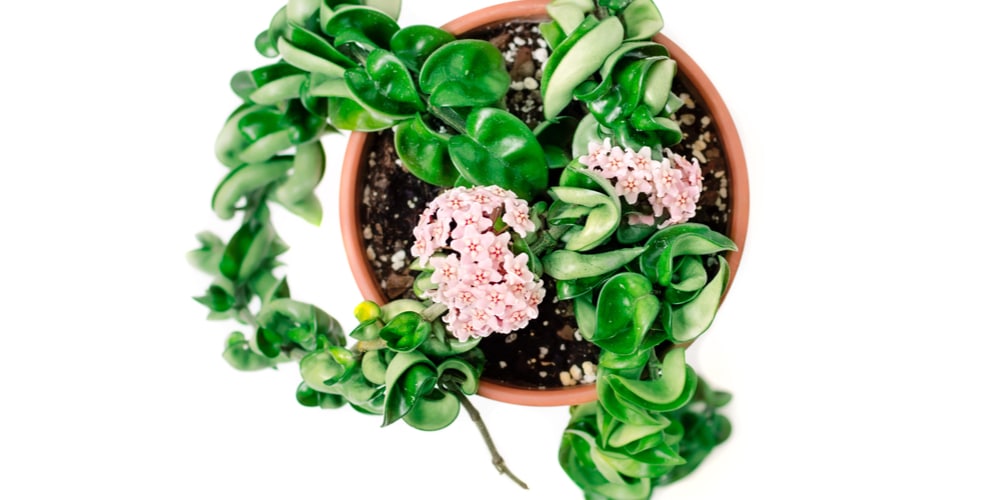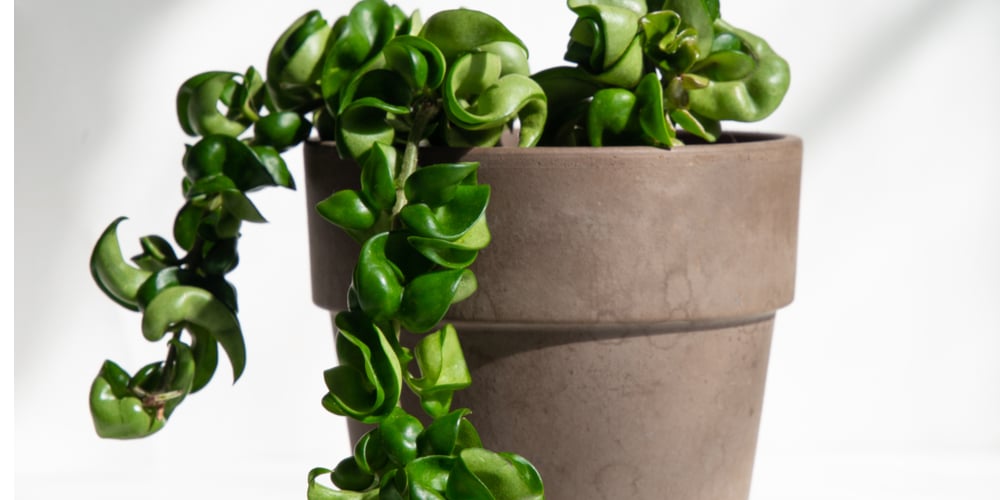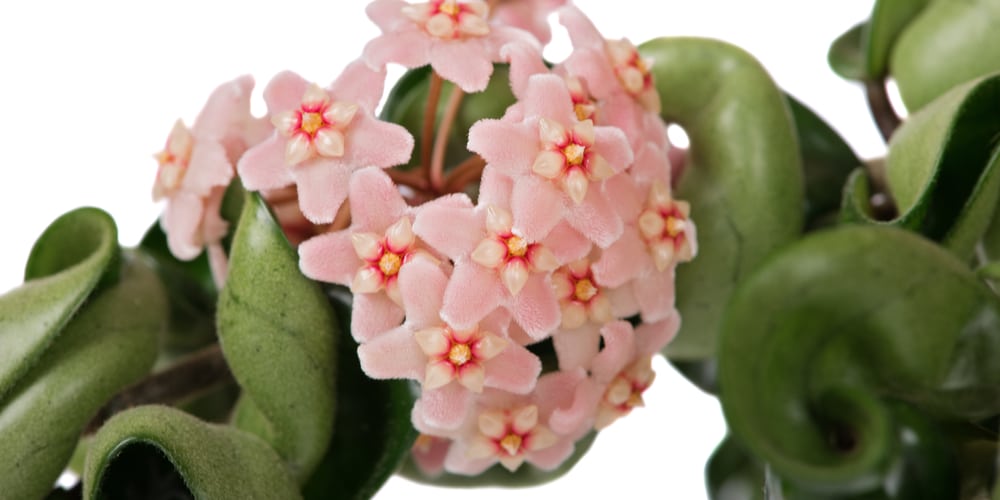Growing and caring for a Hoya plant is always a great experience. If you’re looking for a Hoya variety that can be a great addition to your houseplants, give Hoya Compacta a try. This Hoya variety is recommended for beginners. This only means that Hoya Compacta is easy to grow and care for, especially if you place it indoors.
The Hoya Compacta plant is remarkable for being slow-growing but always worth the wait. Its vines and leaves are enough to leave you in awe, but when the plant blooms with flowers, the plant will be even more beautiful.
If you need help with growing and caring for Hoya Compacta, then you’ve landed on the right page! Here is everything you need to know in order to have a thriving Hoya Compacta houseplant.
- Botanical Name: Hoya carnosa ‘Compacta’
- Common Name: Hindu Rope Plant
- Plant Type: Perennial
- Flower Color: Pinkish-white, small, clustered, and star-shaped
- Size When Mature: 15 inches
- Bloom Time: Spring, summer
- Sun Requirements: Bright, indirect sunlight
- USDA Hardiness Zone: 10 to 12
- Soil PH Range: 6.1 to 7.3
- Soil Type: Well-drained, well-aerated
- Water Needs: Average
- Native Area: Southern India, East Asia, Australia
What You Need to Know About Hoya Compacta
Hoya Compacta is an evergreen perennial, so expect to see the waxy and curled dark-green leaves even in the cold winter months. It is also an epiphyte, or an air plant, that will thrive when planted in hanging pots or near a structure.
This way, the thick, rope-like vines can freely climb or crawl as they grow. It will take up to 3 years for Hoya Compacta to get established. When the plant matures, it will bloom with pinkish-white, star-shaped flowers that will last for 2 to 3 weeks. The blooming time is in early spring and summer and the flowers have a sweet, fragrant smell.
Hoya Compacta is easy to grow and care for. When you provide the plant with its growth requirements, it can even live for up to a decade. Hoya Compacta makes a great houseplant, not only because of its exceptional vines, leaves, and flowers but also because it’s not toxic to you and your pets.
How to Care for Hoya Compacta
Always keep in mind that Hoya Compacta is a vining plant. It thrives when you let it climb freely on a trellis for support or trail down the pot. Hoya Compacta is best grown indoors because it requires specific growing conditions like a specific temperature range.
If you grow them indoors, you can easily adjust the room temperature, humidity, and lighting to how the plant likes it. However, Hoya Compacta makes beautiful hanging plants, especially when you place them on your deck area, summer patio, or balcony. Just make sure that they get indirect sunlight and that you live in a region with a tropical climate. Here is everything you need to know about growing and caring for a thriving Hoya Compacta.
Light
Hoya Compacta is native to tropical regions, so expect that it thrives best in hot weather conditions. When you grow Hoya Compacta indoors, make sure that the plant gets at least 3 to 4 hours of bright, indirect sunlight. You can place the pot near an east or south-facing window.
If you plan to grow Hoya Compacta in a hanging pot, place the pot where the plant can get indirect light. Bright and indirect light are two lighting requirements for Hoya Compacta.
Take note that the plant cannot survive direct sunlight, especially in the afternoon, because it can scorch the flowers and the leaves. Once the vine blooms with flowers, avoid changing the position of the pot because this can disrupt the growth of the plant. Hoya Compacta doesn’t like to be rotated, so choose your planting position wisely.
Water and Soil Needs
The leaves of Hoya Compacta are succulent. It can store water for the plant. In terms of watering, Hoya Compacta is not so demanding. It will grow even with minimal watering. However, during the growing season, the plant may need a little bit of help because moisture is needed for them to bloom.
Water the plant once the top 2-3 inches of its soil becomes dry. Since Hoya Compacta thrives in humid conditions, spray the plant during the warmer months. Avoid overwatering, especially during the winter.
Hoya Compacta needs well-draining, lightweight, and well-aerated soil. They like the soil to be slightly acidic and slightly alkaline. This means 6.1 to 7.3 pH. Refresh the soil every 2 or 3 years.
Temperature Requirements
Hoya Compacta cannot survive cold winters. When you expose it to cold temperatures, the leaves will get damaged and turn yellow. It thrives best in the USDA hardiness zones 10 to 12. If you live in regions with winter temperatures going as low as 20 degrees F, it might be best to grow Hoya Compacta indoors where you can easily control the temperature.
Maintain an indoor temperature of at least 45 degrees F. During the day, set the temperature to at least 70 degrees F and then lower it to 60 to 65 degrees F at night.
Fertilizer
Hoya Compacta doesn’t need fertilizer in order to grow. It will live when you just provide it with well-drained and rich soil. But if you want to put in fertilizer, you are free to do so.
This will ensure that the plant will grow healthy and bloom with beautiful flowers once it reaches maturity. The best fertilizer to use on the Hoya Compacta is a diluted water-soluble fertilizer. Feed the plant every 2 to 3 months during their growing season. Avoid fertilizing the plant in the winter months.
Common Diseases
Yellow leaves and wilting are two common problems in growing Hoya Compacta. Overwatering and poorly drained soil can cause the leaves to yellow while wilting is a sign that the plant needs to be transferred to a bigger container.
Common pests for Hoya Compacta include sap-suckers such as aphids, mealybugs, and spider mites. Use insecticidal soap with warm water and neem oil to get rid of these harmful insects.
Hoya Compacta Propagation
Stem cutting is the easiest and most effective way to propagate Hoya Compacta. Choose a stem that is healthy and can give you a 4-inch piece that has 2 or 3 nodes and a set of leaves.
Remove the leaves from the lower part before you plant the cutting in well-drained and well-aerated soil. After a few weeks, you’ll see new growth above the soil. This means the cutting is ready to be transplanted to its permanent container. It will take 3 years at most for the plant to get established, so make sure that you provide the cutting with its growth requirements to ensure that it will really bloom when it matures.
How to Prune Hoya Compacta
The Hoya Compacta plant doesn’t necessarily need pruning. But if you want to improve the plant’s overall appearance, you are free to trim your Hoya Compacta plant. You only prune the plant once a year, during the spring season.
Cut the stems that are dead and damaged. Remove yellow, brown, or dead leaves. It is critical that while pruning the Hoya Compacta plant, you avoid cutting or removing any stems with old or new spurs because that is where the flower grows.


